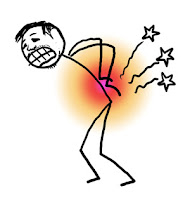Majority of clinic visits in to a general physician are for
longstanding headache, backaches, joint pains, chest discomfort; pain anywhere
in the body. Pain is a neurological symptom, that has a medical cause and it
demands specific medical treatment. Many varieties of arthritis, degenerative
illnesses, migraine and muscle spasms; all are associated with longstanding
pain. However, any pain that lasts for more than 3 months certainly has some
psychological contributions to it. Such pain is medically well understood as
chronic pain.
A very interesting medical fact about pain (which also makes
it complicated) is that all physicians feel that patients tend to exaggerate
their complaints of pain. This again has a strong subjective emotional
component. Thus, any pain can never completely somatic or psychic, it is always
psychosomatic. A soldier on the battlefield does not feel the pain of 5 bullets
in his abdomen, until the time he has reached the hospital bed. Then the pain
is excruciating, unbearable and unreal (and rightly so). The nerve fibers that
carry pain signals to the brain are filtered through the emotional centers.
That is how emotions modulate pain. When one is happy, the pain of arthritis or
neuralgia doesn't hurt too much.
Symbolic pain
Empirically it has been observed that specific areas of the
body have symbolic correlations with pain that arises in them. A housewife, who
is feeling bogged down by her daily routine, several hours of household work,
pressures from the family, worries about the children and financial stressors;
commonly develops a chronic tension headache. She has the worldly stresses on
her ‘head’. This pain is localized to the area above the forehead and is
expressed a constant heaviness (like all the pressures of the world thrown over
her). Likewise a 19 year old boy who has just broken up with his girlfriend,
feels a constant pressure and tightness in his chest, giving him restlessness,
fear of a heart problem; and chest pain. His heart is truly ‘broken’ and gives
him unexplained pain. The office executive working for 11 hours on his seat,
bearing the load of his family responsibility may feel over stressed and
develops a chronic backache. He is the beast of burden who has the world’s load
on his back that unquestionably gives him pain.
Pain and Emotion
Pain signals get influenced by emotions and thoughts, which
in turn affect neurological transmission and alter the pain experience. Internal
analgesics in the body include endorphins that are released in times of
pleasure and happiness. That explains why one feels less pain when one is
happy. The cycle is true in reverse too. Sadness accentuates physical
perception of pain while pain precipitates depression.
Pain and psychopathology
Any chronic pain condition triggers irritability, anger, frustration
and resentment. It leads to a complete change in one's outlook towards things
because it is enduring and constant so it ends up becomes nagging and irksome. The person in pain becomes ‘painful’ to have
around. The bitterness of the pain spills into the individual’s personality.
Pain management
Pain is agonizing and ought to be treated delicately.
Medications can control inflammation, however pain pathways are pretty complex
and medications fail to act in many of these. Yoga or meditation for instance
can release endorphins that block the pain signals in the spinal pathway.
Scientific evidence has endorsed this repeatedly. Psychotherapy techniques can be used to manage chronic pain and the negative emotional
experience associated with it. Systematic relaxation techniques and biofeedback
help in easing muscle tension and lactate buildup that is responsible for accentuating
pain. One needs to learn how to alleviate one’s own pain a cope with it. Life
ought to be beautiful and pain free.


No comments:
Post a Comment